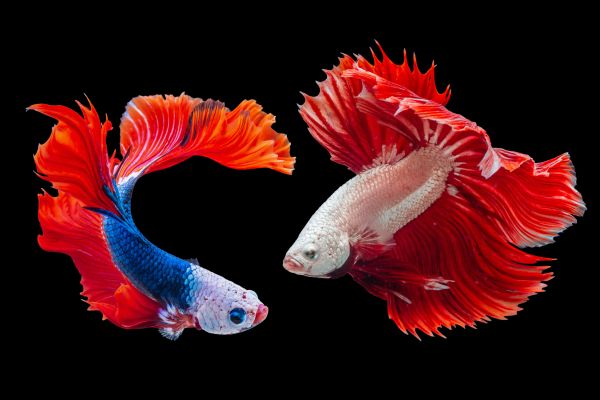Thoughts Are Made to Be Thrown Out

When I was a kid we had an aquarium with a betta in it, also known as a Siamese fighting fish. We were told that male betta fish try to kill each other on sight, so you are definitely not supposed to hold a mirror up to the side of the tank to make it look like it has a competitor.
Of course we had to try it once, and it did indeed try to fight its mirror-bound intruder, so my dad made us stop before it hurt itself. When we took the mirror away, it resumed its normal routine of lazily swimming around, as though its foe had never been there at all. It didn’t seem to remember the other fish or worry about it.
I assume it moved on so quickly because fish do not have the ability, as we do, to entertain imaginary scenarios in their heads. They respond to what they’re experiencing — a hostile fish staring at them, an attractive fish flirting with them — but they don’t swim around reminiscing about past scuffles and rehearsing potential future ones. As a salmon flings itself upstream, it does not suffer recurring mental images of being torn apart by a bear or filleted on a rock. It just swims and eats as instincts dictate, and maybe it will make it and maybe not, but it doesn’t agonize over its range of possible fates.
We humans are so used to fretting over predicted and remembered scenarios that we forget that our entire lives still occur in the present, including all of that fretting about hypotheticals. We can barely imagine what it’s like for most animals, who only experience what’s actually happening. We can’t imagine it because that means we’d be imagining what it would be like to never have developed imagination.
And think about how crazy a development that was: at some point, one of earth’s creatures began to experience a new kind of sense perception. It began to experience ghostly images and sensations representing events that happened to it in the past, and could happen again later, and these sensations inform the creature’s actions in the present, perhaps even to defy its instincts!
A creature that has these surreal visions might be inclined to avoid same bushes where it once got snapped at by a snake, or to seek a certain field marked by a Y-shaped tree, where it once found too many seeds to carry. These mysterious, wispy sensations (which we know now as thoughts) were so useful in bolstering survivability that their descendants still live today, and are in fact us.
Unfortunately, there’s a huge downside to having this ability, which is that these hypothetical mind-events cause us a lot of pain. We relive years-old humiliations, read the wrong things into people and situations, ache for pleasures we don’t have access to, and fret over catastrophes that never happen. Thought alone can make a perfectly healthy creature completely miserable.
Thoughts aid survival by letting us test out propositions without having to act them out and trigger their full consequences. As philosopher Alfred North Whitehead is credited as saying, “The reason we have thoughts is so that our ideas can die instead of ourselves.” To think about something is to summon up visions of multiple paths into the future, and assess which paths might end well and which might not. By interrogating a few prospective future paths, you can throw out the ideas that look like they’ll end in your doom (pick berries by the snake-hole; go up to that other guy and take his furs) and act out the ones that hedge against those dangers (make the longer trek to a snakeless food source; refrain from snatching the furs and angering someone bigger than you). In this way, thinking helps us circumvent much of the natural carnage of real-life trial and error — your unwise ideas can die instead of you.
In other words, thinking can greatly reduce the cost of trial and error, because most of our trials can be mental instead of physical.
However, that means using this ability is hard on our psyches. Thinking of your doom triggers much of the same emotional suffering as real-life pains and losses, it’s just that your bones and tissues remain safe. A fish might experience the sensation of being mauled by a predator once in its life. For us, it could be a thousand times — the specter of doom is much more prevalent in our experience.
Recognizing thought for what it is — a mild hallucination that offers a physically safer form of trial and error — can spare us a lot of that kind of suffering. If thoughts are meant to die instead of ourselves, it’s vital that we do let them die. We need to make sure we dispose of thoughts after they’ve made their appeal, because they’ll stick around as long as you let them. In my experience, a train of thought will insist on its own necessity as long as you humor it, just as even the lowest-quality job applicants will remain in sell-themselves mode until they’re politely shown how to leave the premises.
When I wrote about the corner glimpsing exercise a few months ago, my intention was to show people something an easily overlooked fact about thoughts: they can be thrown out. You can simply drop them mid-spiel:
Throwing out thoughts is something to practice, using a technique like Corner Glimpsing or just by uttering an inner “No thanks” and doing something with the body instead. You just drop it and move, putting your attention into anything physical and real.
This “drop-and-move-on” move feels dangerous at first. This is because the mind knows you’re abandoning mental trial-and-error for the physical kind again, and the mind’s entire purpose is to keep the body from messing itself up in the real world. The mind forgets, though, that ultimately the body is the part of you that has to get on with things and live in that real world, and nothing good can happen until it starts doing that again.
***
Photos by Worochat Sodsri, Brandon, and Simon Berger


